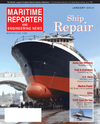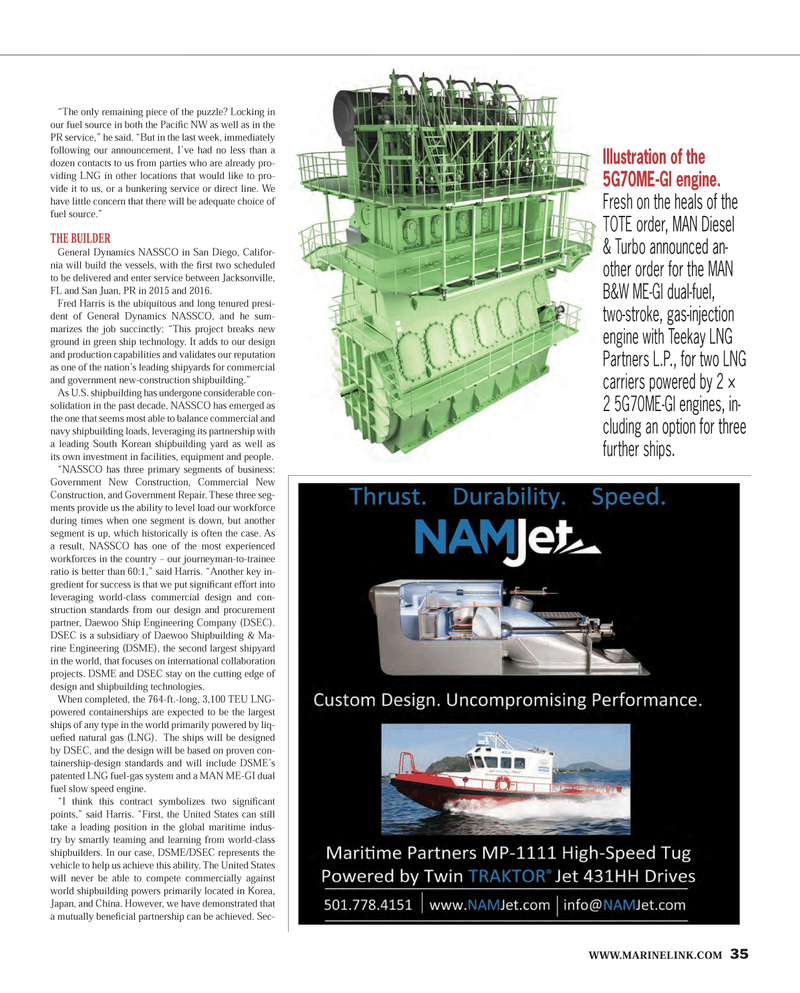
Page 35: of Maritime Reporter Magazine (January 2013)
Ship Repair & Conversion
Read this page in Pdf, Flash or Html5 edition of January 2013 Maritime Reporter Magazine
WWW.MARINELINK.COM 35?The only remaining piece of the puzzle? Locking in our fuel source in both the PaciÞ c NW as well as in the PR service,? he said. ?But in the last week, immediately following our announcement, I?ve had no less than a dozen contacts to us from parties who are already pro-viding LNG in other locations that would like to pro-vide it to us, or a bunkering service or direct line. We have little concern that there will be adequate choice of fuel source.?THE BUILDERGeneral Dynamics NASSCO in San Diego, Califor- nia will build the vessels, with the Þ rst two scheduled to be delivered and enter service between Jacksonville, FL and San Juan, PR in 2015 and 2016. Fred Harris is the ubiquitous and long tenured presi-dent of General Dynamics NASSCO, and he sum-marizes the job succinctly: ?This project breaks new ground in green ship technology. It adds to our design and production capabilities and validates our reputation as one of the nation?s leading shipyards for commercial and government new-construction shipbuilding.?As U.S. shipbuilding has undergone considerable con- solidation in the past decade, NASSCO has emerged as the one that seems most able to balance commercial and navy shipbuilding loads, leveraging its partnership with a leading South Korean shipbuilding yard as well as its own investment in facilities, equipment and people.?NASSCO has three primary segments of business: Government New Construction, Commercial New Construction, and Government Repair. These three seg- ments provide us the ability to level load our workforce during times when one segment is down, but another segment is up, which historically is often the case. As a result, NASSCO has one of the most experienced workforces in the country ? our journeyman-to-trainee ratio is better than 60:1,? said Harris. ?Another key in-gredient for success is that we put signiÞ cant effort into leveraging world-class commercial design and con-struction standards from our design and procurement partner, Daewoo Ship Engineering Company (DSEC). DSEC is a subsidiary of Daewoo Shipbuilding & Ma-rine Engineering (DSME), the second largest shipyard in the world, that focuses on international collaboration projects. DSME and DSEC stay on the cutting edge of design and shipbuilding technologies. When completed, the 764-ft.-long, 3,100 TEU LNG- powered containerships are expected to be the largest ships of any type in the world primarily powered by liq-ueÞ ed natural gas (LNG). The ships will be designed by DSEC, and the design will be based on proven con-tainership-design standards and will include DSME?s patented LNG fuel-gas system and a MAN ME-GI dual fuel slow speed engine. ?I think this contract symbolizes two signiÞ cant points,? said Harris. ?First, the United States can still take a leading position in the global maritime indus-try by smartly teaming and learning from world-class shipbuilders. In our case, DSME/DSEC represents the vehicle to help us achieve this ability. The United States will never be able to compete commercially against world shipbuilding powers primarily located in Korea, Japan, and China. However, we have demonstrated that a mutually beneÞ cial partnership can be achieved. Sec- Illustration of the 5G70ME-GI engine. Fresh on the heals of the TOTE order, MAN Diesel & Turbo announced an- other order for the MAN B&W ME-GI dual-fuel, two-stroke, gas-injection engine with Teekay LNG Partners L.P., for two LNG carriers powered by 2 × 2 5G70ME-GI engines, in-cluding an option for three further ships. MR #1 (34-41).indd 35MR #1 (34-41).indd 351/2/2013 1:14:02 PM1/2/2013 1:14:02 PM

 34
34

 36
36
